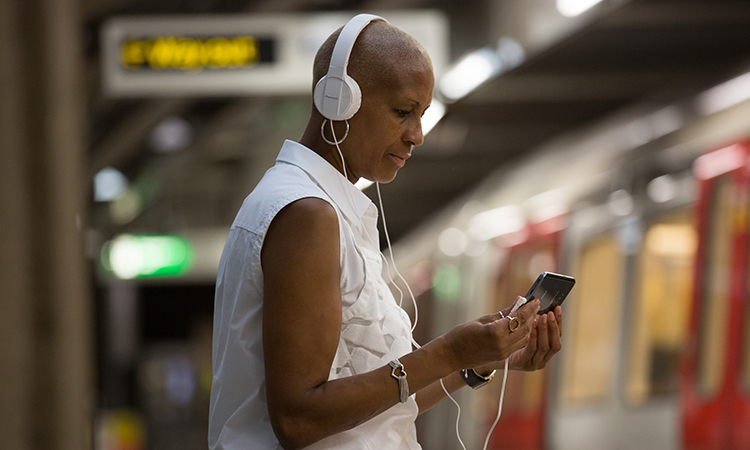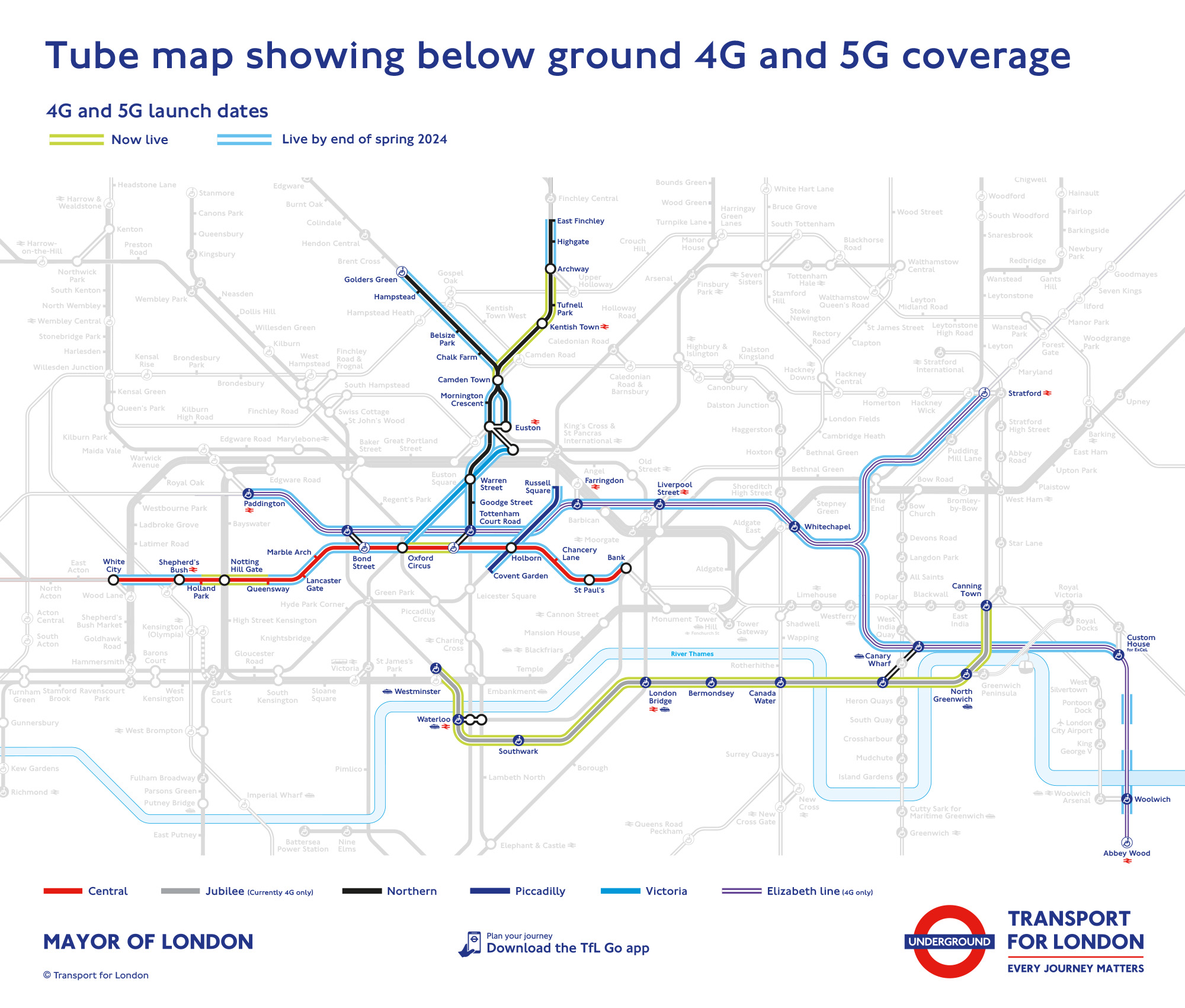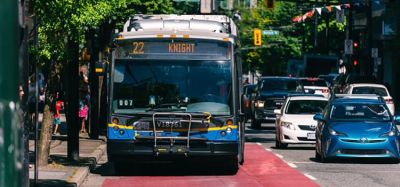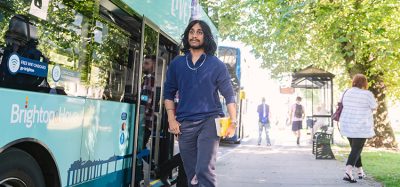Mayor of London outlines next phase of 4G and 5G implementation on London Underground network
- Like
- Digg
- Del
- Tumblr
- VKontakte
- Buffer
- Love This
- Odnoklassniki
- Meneame
- Blogger
- Amazon
- Yahoo Mail
- Gmail
- AOL
- Newsvine
- HackerNews
- Evernote
- MySpace
- Mail.ru
- Viadeo
- Line
- Comments
- Yummly
- SMS
- Viber
- Telegram
- Subscribe
- Skype
- Facebook Messenger
- Kakao
- LiveJournal
- Yammer
- Edgar
- Fintel
- Mix
- Instapaper
- Copy Link
Posted: 18 September 2023 | Intelligent Transport | No comments yet
With the first West End stations going live with 4G and 5G mobile coverage, the next steps for wider implementation across the network have been outlined.


Credit: Transport for London
The Mayor of London, Sadiq Khan, has set out the next phase of the introduction of high-speed mobile coverage across the London Underground (Tube) network as the first stations in the West End go live with 4G and 5G mobile coverage.
On 8 September 2023, customers using the Central line between Oxford Circus and Tottenham Court Road were the latest to benefit from 4G and 5G coverage in the ticket hall, on escalators and on Central line platforms – keeping them connected as they travel to and from the West End to shop, meet friends and visit the area’s theatres, restaurants and bars. Coverage has also been introduced to the Northern line platforms at Tottenham Court Road.
All four mobile network operators – Three UK, EE, Vodafone and Virgin Media O2 (VMO2) – are taking part in the rollout, which has already delivered 4G on sections of the Jubilee, Northern and Central lines. By the end of 2023, 33 stations with platforms that are underground, and therefore usually unable to get a mobile signal, as well as connecting tunnels, will have mobile coverage, increasing to more than 40 stations by Spring 2024.
The introduction of 4G and 5G mobile coverage across the Tube network is being delivered for the Mayor of London and Transport for London (TfL) by Boldyn Networks, and is seeing high-speed mobile coverage provided within stations and tunnelled sections of the Tube network, allowing customers to get the latest travel information, access social media, check their emails, make calls and stream videos while passing through the station.
Providing uninterrupted mobile coverage also provides additional reassurance to those travelling on the network and will make it easier for customers to contact friends and family while travelling. It will also host the new Emergency Services Network (ESN) which, when fully operational, will give first responders immediate access to life-saving data, images and information in live situations and emergencies on the frontline.


Credit: Transport for London – Mobile coverage Tube map, as of September 2023.
The rollout to Oxford Circus and Tottenham Court Road follows Camden Town and Mornington Crescent stations getting high-speed mobile coverage earlier in 2023. Customers using the Charing Cross branch of the Northern line at Euston station will also get 4G and 5G coverage in the coming weeks – benefitting those arriving to the city from Liverpool, Manchester, Milton Keynes and Crewe who then change to the Tube to complete their journey.
In the coming months, further stations along the Northern and Central lines such as Goodge Street, Chancery Lane and Bank will get mobile coverage, helping the millions of visitors who come to Central London and, in particular, the West End every year to better navigate the capital. Boldyn will also be progressing work to introduce mobile coverage to the southern end of the Northern line, with the first sections going live during Summer 2024.
The Mayor has also confirmed that the first stations on the Elizabeth line to benefit from high-speed mobile coverage will be Bond Street, Tottenham Court Road, Farringdon and Liverpool Street. These stations will be live by the end of 2023, with all stations and tunnelled sections getting 4G coverage by the end of Spring 2024.
As well as bringing mobile coverage to more stations in the coming months, Boldyn Networks will also begin to upgrade the existing coverage on the Jubilee line to allow 5G to be available at stations, such as Canary Wharf and North Greenwich, for the first time. Given the progress made, the Mayor, TfL and Boldyn have also now agreed a deal to extend mobile coverage to the Docklands Light Railway (DLR) and the London Overground between Highbury & Islington and New Cross.
This means that 5G coverage will be delivered on top of 4G coverage, and will be extended to the Elizabeth line, DLR and London Overground, as well as the Tube. TfL expects a significant proportion of the entire Tube network (around 80 per cent of stations across the network) and the Elizabeth line to have mobile coverage by the end of 2024.
Sadiq Khan, the Mayor of London, said: “I am delighted to see the promise I made of delivering 4G and 5G across the London Underground continuing to progress, with West End hubs Oxford Circus and Tottenham Court Road joining an ever-growing network of line and stations with full connectivity. This means that Londoners and visitors can now access the latest travel information or social media, check their emails, make calls and stream videos whilst on the move underground. Growing numbers of underground Tube stations now have 4G and 5G services, with many more to come as we continue to build a better London for everyone.”
Andy Lord, London’s Transport Commissioner said: “It’s great to see the first Tube stations in the West End getting high-speed mobile coverage on their phones within the station, as part of the next stage of our project with Boldyn Networks to bring 4G and 5G to the whole Tube network. We are committed to delivering this programme, which will allow customers to be more connected underground and get the latest travel information and news, as well as stay in contact with work, friends and families while travelling on our network. More stations, including the first Elizabeth line stations, will be connected in the coming months, and we remain committed to having a significant proportion of the entire Tube network connected by the end of 2024.”
Currently, more than 10 per cent of London Underground stations with platforms that are underground, and therefore usually unable to get a mobile signal, now have 4G and 5G mobile coverage. When combined with sections of the Tube which are above ground, this means that around 60 per cent of the whole network has mobile coverage.
Related topics
5G & Transport Communications, Passenger Experience, Public Transport
Related modes
Underground
Related cities
London
Related countries
United Kingdom
Related organisations
Boldyn Networks, EE, Three UK, Transport for London (TfL), Virgin Media O2 (VMO2), Vodafone
Related people
Andy Lord, Sadiq Khan








